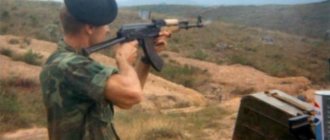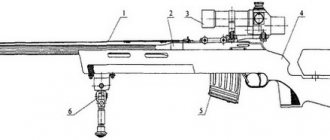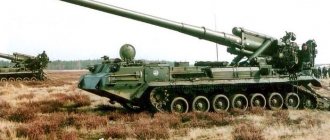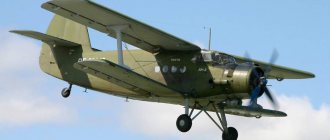In the early 60s, the excellently proven Tu-104, Il-18 and AN-10 aircraft were firmly established on Aeroflot's medium-length airlines of 1,500 to 3,500 km. Of these, the Tu-104 and its modifications had the highest cruising speed and provided the best comfort. The AN-10 had the best takeoff and landing characteristics. Il-18 had the longest flight range and the best economic performance. The domestic civil air fleet had at its disposal three completely different passenger aircraft of the same class, which led to difficulties in ensuring the normal process of technical operation of a fleet of aircraft that were structurally significantly different from each other.
Therefore, it was during this period that the question of replacing three different types of aircraft, operated on practically the same airlines, with one came up on the agenda. At the same time, a condition was put forward: the new aircraft had to incorporate the best qualities of its predecessors, taking into account some new regulatory requirements for passenger aircraft, which just began to be introduced during the creation of the Tu-154, in particular more stringent requirements for takeoff and landing characteristics. It was thought that the new aircraft would be created taking into account the latest achievements of domestic and world aircraft construction. Preliminary work on the aircraft took about 2 years, and during preliminary projects and preliminary design, the aircraft underwent a number of changes, while maintaining the basic ideas included in the original project.
Work at the Design Bureau to find the most optimal design for the future aircraft was headed by the head of the Technical Projects Department S.M. Jaeger. The first work on the Tu-154 aircraft began back in 1963 and was initially a logical development of the Tu-104 aircraft, but with a new tail section for three NK-8 type engines, while preserving the rest of the fuselage and wing of the Tu-104B (Tu-104D project ). At the initial stage of the search for the most rational layout, the Tu-104D project was used as the initial one. In 1964, a draft aircraft was prepared, which already had the designation Tu-154. The layout of the aircraft was similar to the Tu-104D, but had a fuselage diameter of 3.8 m and was designed for 109 passenger seats in the first class passenger cabin layout and 141 seats in the economy version. A special feature of the layout of the passenger cabin was the central kitchen, dividing the cabin into two salons. The forward part of the fuselage is of the Tu-104 type with a glazed navigational cabin and with a ROZ-1 type radar. In order to ensure normal operation of the central engine, the inlet part of its air intake was made at a slight positive angle to the vertical axis. At the same time, a variant of the Tu-154 aircraft was considered with a slightly modified keel shape and the location of the stabilizer and central air intake, reminiscent of those used on the Boeing 727, the nose section without a navigation cabin with a radar nose cone. This option was also studied in several passenger cabin layouts, for example: mixed with 112 seats and economic with 142 seats without a central kitchen. Two power plant options were considered: for three NK-8 engines and for four D-20P-125M engines, with installation in the rear fuselage similar to the Il-62, VC-10 aircraft and the OKB project for the Tu-110D aircraft. In both versions, the fuselage, wing, horizontal tail, rudder and passenger cabin remained unchanged. Only the rear parts of the fuselage with engine nacelles and keel were changed.
By mid-1965, based on a large number of preliminary projects and technical proposals, the appearance of a medium-haul passenger aircraft designed to transport 16,000-18,000 kg of commercial load over a distance of 2,850-4,000 km with a cruising speed of 900 km/h, 5,800 kg of commercial load at 5,800-7,000 km had developed with a cruising speed of 850 km/h, capable of operation in the entire range of take-off weights from 2nd class airfields.
On August 24, 1965, Resolution of the Council of Ministers of the USSR No. 647-240 was issued, according to which the A.N. Tupolev Design Bureau was instructed to design and build a medium-range passenger aircraft Tu-154 with three turbofan engines of the NK-8-2 type with a take-off thrust of 9500 kg each.
It should be noted that a competition was announced for this project of a medium-range aircraft, in which, in addition to the A.N. Tupolev Design Bureau, the S.V. Ilyushin Design Bureau took part. The Ilyushin Design Bureau proposed a project of a three-engine aircraft with three D-30 type engines with a take-off thrust of 6800 kg, the projects were designated Il-72/Il-74 (Il-74 is a later project with an increased number of passengers). The following is a comparison of the proposed projects: Characteristics
| 75-85 | 69-73,3 | ||
| weight of the equipped aircraft, t | 39,6 | 35,6 | |
| maximum payload weight, t | 14-16 | 14 | |
| useful weight yield at maximum commercial load, % | 54,1 | 51,5 | |
| number of passenger seats in the tourist version, people. | 141 | 138 | |
| technical flight range | with maximum commercial load, km | 6450 | 4850 |
| with maximum fuel reserve (at load), km (t) | 7730 (6-10) | 5850 (7,5-10) | |
| economic cruising speed, km/h | 900 | 900 | |
| cruising altitude, m | 12000 | 11000 | |
| required runway length, m | 2500 | 1930 | |
| maximum fuel reserve, t | 28 | ||
| engine weight, kg | 2350 | 1550 | |
| specific fuel consumption at cruising mode, kg/kg.h | 0,76 | 0,79 | |
| aircraft thrust-to-weight ratio, kgf/kg | 0,335 | 0,278 | |
| crew, people | 3 | 4-5 | |
As a result of the competition, the order for a new aircraft was received by the A.N. Tupolev Design Bureau, since the Tu-154 project most fully met the operational requirements of the 70-80s and absorbed everything that was advanced at that time in the theory and practice of domestic aircraft construction . Serial production of the aircraft was supposed to be launched at Moscow, now MAPO), but subsequently the series was transferred to plant No. 18 (KuAZ) in Kuibyshev. On November 20-21, 1965, the MGA tactical and technical requirements for the Tu-154 aircraft were approved. In December 1965, a mock-up commission was held. While all related interdepartmental issues were being resolved, the design bureau was preparing designs for pilot production and the construction of the first prototype of the aircraft was underway on the prototype. A special feature of the requirements of the Resolution and TTT was that for the first time in the practice of designing a passenger aircraft, the requirement “take-off weight” was introduced into the regulatory documents. The requirements put forward for the aircraft were as follows:
#i take-off weight, t 77-80 #i maximum payload, t 15 #i maximum number of passenger seats 160 #i specific fuel consumption NK-8-2, kg/kg.h 0.76 #i practical flight range at maximum commercial load, cruising speed 900 km/h at an altitude of 11000 m, with ANZ for 1 hour of flight, with a take-off weight of 77-80 tons, 3500 km with a commercial load of 15.5 tons, km 4700 - 5000 #i airfield class 2
The first prototype aircraft was supposed to be ready in the spring of 1967, and the first production aircraft was supposed to be ready in the fall of the same year.
The layout of the Tu-154 was based on the design of the Tu-134 aircraft with the power unit located in the rear fuselage. At the time, this was a widespread configuration adopted by many aviation firms, and the Tu-154 aircraft was no exception. Aerodynamic coupling, selection of wing profiles in combination with high thrust-to-weight ratio made it possible to achieve the highest cruising speed compared to other passenger vehicles of a similar type - up to 950 km/h, while simultaneously ensuring good stability and controllability characteristics throughout the entire range of speeds and flight altitudes.
The creators of the aircraft were faced with the task of combining maximum efficiency with maximum flight safety. From the point of view of efficiency, the most preferable was the two-engine design, and according to the requirements of the concept adopted in those years, it was considered that the safest was the four-engine design. For the Tu-154, an intermediate three-engine design was chosen: two engines on the sides in the tail section on pylons and one - inside the rear fuselage with an air intake in the fork and an S-shaped channel. The Tu-154 aircraft project was distinguished from most contemporary passenger aircraft by its chosen high thrust-to-weight ratio - 0.35-0.36 (0.22-0.27 for most aircraft). The situation with the choice of this parameter is not debatable: on the one hand, this can lead to a decrease in the efficiency of the aircraft, but on the other hand, excess thrust guarantees the operation of the aircraft at airports with a runway length of 1500-1800 m and at airports located in highlands and areas with a hot climate. Unlike the Western analogue of the Boeing 727, the Tu-154 was optimized for flights at cruising altitudes of 11000-12000 m (for Boeing - 7600-9150), for this a relatively large wing area of 180 m2 was adopted (for Boeing - 145 m2). The combination of both parameters resulted in the minimum cruising fuel consumption of the aircraft.
The design features of the Tu-154 aircraft project include: #i three-engine design, with the engine thrust in cruising flight switched to a reduced flight mode (0.7-0.75 nominal), which should have had a positive effect on the resource indicators of the power plant; #i high degree of wing mechanization (slats, three-link flaps and spoilers), which made it possible to obtain not only moderate take-off and approach speeds, but also provided ample opportunities for vertical maneuver, which, in turn, provided satisfactory performance in terms of noise on the ground ; #i on the Tu-154 aircraft, for the first time in domestic practice, the principle of multiple redundancy of all major systems was implemented for a passenger aircraft, which was the key to high flight safety and made it possible to design systems according to the principle of safe failure; #i for the first time in the practice of domestic passenger aircraft construction, and even more so in the practice of the Design Bureau, irreversible boosters were used on all control surfaces; #i for the Tu-154, the main chassis with a three-axle bogie was developed, which made it possible to reduce the load on the airfield plate to 17000-19000 kg (unlike the Boeing 727-200A, which has a similar figure of 31000-33000 kg) and improve the braking and aircraft acceleration characteristics; #i Tu-154 became the first OKB aircraft to have an auxiliary power unit installed, which ensured the aircraft's autonomy on the ground; #i for the first time in OKB practice, a primary alternating current system of stable frequency was introduced on the Tu-154, ensuring parallel operation of all main generators, which significantly increased the reliability of the electrical system and improved its operational characteristics; #i for the first time in OKB practice, engine thrust reverser was used on the Tu-154 aircraft, which made it possible to significantly improve the landing characteristics of the aircraft; #i on the Tu-154 aircraft, the automated on-board system BSU-154 (ABSU-154) was introduced, which made it possible to automate the piloting process in almost all flight modes, right up to landing (initially, in accordance with the requirements for the 1st ICAO category, and then during aircraft modernization according to 2nd); #i the Tu-154 aircraft became one of the first aircraft in the OKB practice, in which the principles of integrating on-board equipment were partially applied.
During the design process, the design bureau relied on a wide range of uses for the aircraft. The passenger cabin of the Tu-154 was divided by a buffet-kitchen and a middle vestibule into two salons - front and rear. In the basic version of the layout, the OKB proposed placing 158 passengers in both salons, six in a row, with a seat pitch of 0.75 m. Blocks of seats were installed on rails and could be moved along them with fixation every 30 mm, which made it possible to change the seat pitch from 0.75 up to 0.81 - 0.9 m, which made it possible to quickly accommodate 158, 146 and 134 passengers, depending on the class. In the front cabin, 54 tourist class seats could be replaced by 24 first class seats in the form of two-seat blocks instead of three-seat ones, then the total number of passengers on the plane was reduced to 128 people. On short-haul lines with a flight time of no more than two hours, 164 passengers were supposed to be accommodated by reducing the size of the buffet-kitchen and installing an additional six seats. During the cold season, eight tourist class seats were to be removed in the rear of the passenger cabin and another wardrobe was equipped for 80-82 coats, in addition to the small wardrobes located in the vestibules at each of the two entrance doors to the aircraft. In addition to the considered configurations, options for 110, 122 and a cabin version with an increased level of comfort and intended for special passenger transportation were proposed.
The creators of the Tu-154 aircraft paid special attention to comfort. The elegant decoration of the passenger compartments, the thoughtful layout of the seats, the automatic air pressure control system and the special microclimate satisfied the most demanding passenger.
Already during the design and construction of the first prototype aircraft, the OKB considered a cargo version of the Tu-154 aircraft, designed to transport 25,000 kg over a distance of 2000-2500 km with a cruising speed of 900 km/h. During the same period, a variant of the aircraft with increased fuselage length for 240-250 passenger seats and with a non-stop flight range of 2000-2500 km. During the design process, it was proposed to prepare three main versions of the aircraft: Tu-154A, Tu-154D and Tu-154B. Tu-154A - the main production version; Tu-154D - long-range version with a reduced payload, increased fuel capacity and increased wingspan; Tu-154B is an aircraft with increased passenger capacity and payload due to the insertion of an additional section into the fuselage.
In 1968, the first two Tu-154 aircraft were built in pilot production: one for flight tests (board number 85000, factory KX1), the second for static tests. The first machine in the second half of 1968 was transferred to ZhLI and DB for flight tests. The second aircraft underwent static testing in the OKB's static testing laboratory from November 1968 to May 1971, in parallel with flight tests. The first flight of the Tu-154 prototype aircraft took place on October 3, 1968; The car was lifted into the air by a crew consisting of ship commander Yu.V. Sukhov, co-pilot N.N. Kharitonov, flight engineer V.I. Evdokimov. Leading test engineer L.A. was also on board. Yumashev, experimenter Yu.G. Efimov and flight electrician Yu.G. Kuzmenko. After the development stage and the first flights, the aircraft was transferred to Joint tests, which were carried out in two stages. The first stage practically corresponded to the Factory tests and was carried out by the MMZ “Experience” at the LII airfield. The first stage of testing began in December 1968 and ended in January 1971, the second stage, corresponding to State tests, ran from June to December 1971. The testing routine began, with its joys and constant worries. At various times, crews led by test pilots took part in testing the Tu-154 aircraft: S.T. Agapov, V.P. Borisov, I.K. Vedernikov, B.I. Veremey, E.A. Goryunov, N. E. Kulchitsky, V. M. Matveev, A. I. Talalakin, V. I. Shkatov.
Simultaneously with the start of Tu-154 testing, the preparation and deployment of serial production of the aircraft at KuAZ was underway (the aircraft was put into production at KuAZ in 1968. Previously, for this, the OKB had to rework the serial technology and make the necessary changes to the design that met the specifics and organization of KuAZ production (initially The Tu-154 was supposed to be mass-produced in Moscow, but due to the heavy workload of the plant with the production of MiG-21 fighters and the development of the first MiG-23, the Tu-154 series was transferred to Kuibyshev).All this could not but affect the construction time and quality of the first production vehicles , the first of which began to fly in 1970, and which became actually pre-production aircraft and took part in Joint tests. However, despite serious difficulties, KuAZ produced the lead batch in a relatively short time and modified it in accordance with the results of State and operational tests .
In addition to testing under the main Joint Test program, Tu-154 aircraft performed flights under the special flight test program. Two aircraft Nos. 85001 and 85002 flew at high angles of attack, and board 85002 was equipped with an anti-spin parachute and crew rescue equipment. During testing, the aircraft were constantly improved: the flap control system was changed, the ABSU-154 system was improved, etc. On other machines, the power plant, aircraft systems and equipment were completed.
All work on the creation and development of the Tu-154 aircraft at the first stage was headed by Chief Designer D.S. Markov, and then S.M. Yeger. It was they who were responsible for all the main problems associated with the testing and development of the aircraft in the series. On May 25, 1975, A.S. Shengardt was appointed head of work on the Tu-154 aircraft, who then became the Chief Designer for this aircraft and its numerous modifications, who led and still manages the entire range of work related to the improvement of the Tu-154.
During the first stage of testing in 1969, the prototype Tu-154 aircraft was demonstrated at the salon in Le Bourget.
Flight tests of the Tu-154 lasted almost 5 years. Leading aircraft No. 85000-85005 never entered mass service. Aircraft No. 85005 is now at the All-Russian Exhibition Center in Moscow as an exhibition piece. It is curious that aesthetically it is absolutely not outdated or old-fashioned.
At the end of 1970, operational tests of the first aircraft began on Aeroflot lines. Operational tests were already carried out on six production aircraft (according to No. 85013). At the same time, retraining of crews for a new type of passenger aircraft began. The cradle of the car was Vnukovo - that legendary airline that gave way to the skies for almost all Tupolev civil aircraft. According to order No. 531 of December 15, 1970, acting commander of the Vnukovo Production Association (VPO) B.E. Pashokov (future Minister of Civil Aviation of the USSR), pilots of the 200th flight detachment - commanders of ship B - were appointed for operational tests of the Tu-154 .V.Borisov, G.N.Kuzichev, B.K.Modin, Yu.M.Secretaryov. The first crews included - along with the co-pilot, navigator, and flight engineer - also radio operators. Operational tests were carried out at Vnukovo until May 1971.
In May 1971, the Tu-154 began to be used to transport mail from Moscow to Tbilisi, Sochi, Simferopol and Mineralnye Vody. The airliner entered the Aeroflot routes at the beginning of 1972. The Tu-154 made its first regular flight Moscow - Mineralnye Vody on the day of the 49th anniversary of Aeroflot - February 9, 1972. Flight 709 was carried out by a crew consisting of ship commander E.I. Bagmut, co-pilot A.V. Alimov, navigator V.A. Samsonov and flight engineer S.S. Serdyuk. On February 25, 1972, regular flights on the Tu-154 from Vnukovo to Simferopol began. In 1973, operation of the Tu-154 began in Novosibirsk (Tolmachevo).
Tests of the Tu-154 basically confirmed its flight characteristics, but also showed that the aircraft requires further improvement in terms of increasing the reliability of some of its structural components, assemblies, improving manufacturability and changes in the layout of the passenger cabin. However, the main problems of the aircraft were ensuring a given resource and the introduction of an automatic approach system to a height of 30 m. Subsequently, the entire development of the Tu-154 aircraft, until the advent of the Tu-154M modification, revolved mainly around solving these problems. Modifications of the Tu-154A and several variants of the Tu-154B with NK-8-2U engines with increased thrust were subsequently created, in which these tasks were successively solved as operating experience was gained and the necessary systems, units and equipment were ready.
The removal of the AN-10 and Tu-104 from service and their replacement with Tu-154 aircraft significantly increased the level of flight safety and aviation culture in our country.
History of the IL-72 project
After the closure of the project to develop the P-20 projectile aircraft, the Ilyushin Design Bureau decided to start creating a supersonic passenger aircraft. This incident became one of the most important experiences of the enterprise. The designers decided to use special durable alloys in the new airliner. The car was supposed to transport at least 100 people over long distances, accelerating up to 3000 km/h.
The presence of such an aircraft could solve many problems, including reducing the time spent on long flights and increased fuel consumption. The airliner being designed was named Il-66. Its design used a canard aerodynamic design with a delta wing. Its engines were mounted in the rear of the hull.
IL-66 aircraft diagram
In 1960, Ilyushin himself turned to the Council of Ministers and asked to include the aircraft in the list of future construction, declaring the possibility of presenting a prototype of the machine by 1963. After the research, the State Committee called the development of the Il-66 an overly complex task. Nevertheless, there was no refusal to further implement the project.
It was only proposed to consider the option of an airliner using standard alloys and a lower flight speed. By 1962, revised design documents were prepared. Now the plane could carry only 60 people over a distance of 4,500 km and accelerate to 2,690 km/h.
After this, the design bureau was faced with a lack of resources for further work on the Il-66, and all available forces were busy creating other projects. Soon the Tupolev Design Bureau presented a similar aircraft called the Tu-135P. Despite the presence of an almost finished version of the Il-66, the leadership of the air fleet clearly supported the new project.
The creation of the airliner by the Ilyushin Design Bureau was finally stopped. But the Tu-135P was not destined to become the main fleet - the project was closed, and instead the development of another vehicle began.
Tu-135P
Soon after the abandonment of the Il-66, the design bureau began thinking about creating a new airliner. The reason for this was the need to develop advanced aircraft to replace outdated models that could not cope with their tasks. The civil air fleet urgently needed an airliner that would have increased passenger capacity and be able to transport people over medium distances, while simultaneously replacing the Tu-104 and Il-18.
At the same time, the new car was supposed to become less expensive, having received the minimum cost of flights. Also important was the ability to operate the aircraft on runways whose length does not exceed 2 km. The development of suitable projects began in several enterprises at once, including the bureaus of Ilyushin, Tupolev and Antonov.
IL-70
One of the first options proposed was the Il-70. He could hardly satisfy the demands put forward and in some respects lagged significantly behind them. It was presented only because this aircraft was being developed in parallel with the Yak-40, which had already been approved and was supposed to become its competitor.
Despite the delay, the OKB decided to demonstrate their work by replacing the R19M engines with AI-25, but this did not give the expected results - the airliner did not arouse any interest. In 1963, designers began developing the Il-72 model. The plane was supposed to be a medium-haul passenger airliner powered by turbojet engines. Several types of layout were considered, differing in a number of details.
Layout of the IL-62 aircraft
The most promising seemed to be the repetition of aerodynamics from the Il-62. According to the scheme, it was planned to install four D20P-125M turbojet engines in the tail section of the airliner. With this option, the vehicle could transport up to 18 tons of commercial load over a distance of 3,500 km. In 1964, the project went through modifications that slightly changed the layout. Now the Il-72 was supposed to install three AI-35 turbojet engines in the tail section.
Engine AI-35
In 1965, all work on the Il-72 was suddenly stopped. The reason for this was the launch of the Il-74 project using D-30I engines. The new aircraft had a similar layout and could accommodate up to 144 passengers. It became even more economical, which gave great hope for the car’s popularity in the aviation market. The flight speed reached 900 km/h, the range was limited to 2750 km.
Take-off and landing could be carried out on short runways, the length of which did not exceed 2 km. Despite the attractive technical indicators, the project was closed in 1965. The reason was the demonstration of the Tu-154, superior to the Il-72 and Il-74 in all respects. The new development of the Tupolev Design Bureau met all the requirements of civil aviation and immediately aroused great interest. Everyone has forgotten about Ilyushin’s latest passenger airliner projects.
Modifications
- Tu-154 is the first production modification of the Tu-154. The aircraft was in serial production at KuAZ from 1968 until the end of 1974, a total of 42 aircraft were produced, the first production aircraft took off in 1970. For 1974, the serial plant, together with the Design Bureau, prepared 16 variants of passenger cabin layouts, the general solutions of which became standard for all subsequent modifications (tourist version for 152 passenger seats, tourist version for 144 seats, tourist version for 158 seats, tourist version for 152 seats with additional exits and special equipment, mixed version for 126 seats, tourist option for 144 seats for foreign transportation, tourist options for 158 seats and 164 seats for Bulgaria, mixed version for 128 seats for Bulgaria, tourist option for 158 seats for Hungary, mixed version for 134 seats for Hungary, a mixed version for 124 seats for Egypt, a mixed version for 120 seats with a luxury cabin for Egypt, tourist options for 145 and 151 seats for Egypt, a “Salon” version of the Tu-154K for 235 JSC Almost all produced Tu aircraft -154 at the end of the 70s were converted into Tu-154B aircraft.Several Tu-154 aircraft belonging to the OKB and located in ZhLI and DB were used as base for various modifications and the introduction of new systems and equipment (new NK-8-2U engines, ABSU-154 2 ser, new logic of operation of controls and mechanization, etc.), becoming in fact prototypes of the Tu-154A and Tu-154B modifications. Of the produced Tu-154s, three were exported: one to Hungary, two to Bulgaria.
- Tu-154A is a serial modification of the Tu-154 with improved flight and operational characteristics, with NK-8-2U engines increasing take-off thrust to 10,500 kg. Tu-154A were produced since 1974, a total of 78 Tu-154A aircraft were built, later all produced Tu-154A were converted into Tu-154B.
- Tu-154B is the most popular modification of the Tu-154. In total, from 1975 until the end of serial production in the mid-80s, 486 aircraft were produced in three versions (Tu-154B, Tu-154B-1 and Tu-154B-2), differing mainly in the layout solutions of the passenger cabin and passenger capacity. On the Tu-154B, the design of the airframe elements was strengthened, the take-off weight of the aircraft was increased, and many aircraft systems and equipment were modified.
- Tu-154E - Tu-154 project for two D-30A engines, with reduced weight and dimensions. The project was considered by the OKB in 1977, but was not further developed.
- Tu-154S - 9 Tu-154 and Tu-154A aircraft converted in the early 80s into cargo aircraft (up to 20 tons of cargo) - a cargo cabin instead of a passenger cabin and a large onboard loading hatch (size 2.8 x 1.87 m) .
- Tu-154T is a project of a tanker aircraft for Tu-22M Long-Range Aviation aircraft, the project did not receive development.
- Tu-154 AWACS - a project of an AWACS aircraft based on the Tu-154 with the Shmel complex, which was considered under the program for creating the Tu-156 AWACS complex in the late 60s and early 70s, did not receive development.
- Tu-154M (initial project designations Tu-154-160, Tu-160A, Tu-164) - further development of the Tu-154 towards further improving its operational characteristics through the introduction of new, more economical D-30KU-154 engines, improvements in local aerodynamics aircraft and airframe units, as well as improving PNO.
- Tu-154M-LL (ULO) is a flying laboratory based on the Tu-154M for studying the problems of laminar swelling control.
- Tu-154MD is a modification project of the Tu-154M with a modified PNK, increased take-off weight, fuel reserves, improved wing aerodynamics, reduced passenger capacity and a practical flight range increased to 6100 km with a maximum payload. The development project was not received.
- Tu-154-100 is a serial modification of the Tu-154M, more limited and cheaper than the Tu-154MD. Mastered in a series in Samara.
- Tu-154M2 is a project for modifying the Tu-154M for two PS-90A-154 engines. For this modification, preliminary design was carried out at the OKB, but the project was not accepted.
- Tu-154M3 is a variant of the Tu-154M2 with NK-93 engines.
- Flying laboratories under the Buran VKS program based on the Tu-154. To train pilots, test and select the optimal automatic landing system for the Soviet aerospace ship Buran, it was necessary to create a number of flying laboratories. For these purposes, five Tu-154 of various modifications were converted for the Buran program, which were actively used in training Buran crews and testing its systems. Subsequently, the Tu-154LK-1 laboratory was prepared on the basis of the Tu-154M according to the same program, with improved characteristics. The Tu-154LK-2 laboratory was in operation.
- Tu-154M “Open Skies” - Tu-154M aircraft converted under the “Open Skies” program. One of the aircraft was converted in Germany. Similar work was carried out at the Tu-154-ON Design Bureau.
- Tu-154R - reconnaissance aircraft, China
Characteristics
| Tu-154 | |
| wingspan, m | 37,55 |
| aircraft length, m | 47,9 |
| aircraft height when parked, m | 11,4 |
| maximum fuselage diameter, m | 3,8 |
| wing sweep along the 1/4 chord line, deg | 35 |
| wing area, m2 | 201,45 |
| horizontal tail area, m2 | 40,55 |
| maximum take-off weight, t | 90 |
| maximum landing weight, t | 75 |
| number of passengers, people | 128-164 |
| maximum payload weight, t | 18 |
| engines | 3 NK-8-2 |
| engine thrust, kgf | 3 x 9500 |
| maximum flight range (with maximum payload and fuel reserve), km | 2720 |
| cruising speed, km/h | 945 |
| maximum indicated speed, km/h | 575 |
| maximum M number (operational) | 0,88 |
| required runway length, m | 2300 |
| crew, persons | 3(4) |
Design
By design, the Il-72 was supposed to have many similar features to the Il-62. It was assumed that it would become a cantilever low-wing aircraft. It was planned to install two doors in the fuselage in the first half of the cabin on the left side for boarding and disembarking passengers. On the right they had to install an emergency door and a special one designed to serve the kitchen. Perhaps there would additionally be emergency exits on the wing, like the Il-62. In total, up to 159 people could fit inside.
Design of IL-62
The wing for the Il-72 had a swept-back shape and was three-spar. It was supposed to have advanced mechanization, consisting of flaps and slats installed along the entire length of the wing. The engines according to the project were located in the tail section. In the version with three installations, it was planned to mount one on top and two on the sides. If a four-motor design were used, they could be installed in pairs.
The project involved the installation of a three-legged chassis. The front support consisted of two wheels and was located in the bow of the hull. A pair of main ones would be mounted under the wing near the fuselage. They included two pairs of dual wheels. The type of folding of the landing gear is unknown, but they were supposed to be retracted inside the wing and fuselage.
Have you seen the rare IL-72 plane?
Not really
Airplane appearance
For a passenger aircraft, the Il-66 looked unconventional. The choice of design was due to the spread of the delta wing and the installation of engines at the rear of the vehicles. The name of its layout was memorable - a duck with a front floating horizontal tail. The use of such a solution is also due to the fact that it was impossible to achieve the desired flight characteristics in other versions.
Airplane appearance
In other parameters, the airliner looked standard. It was planned to install a low-lying wing with an increased area. The passenger compartment had to accommodate the required number of passengers and was no different from its counterparts in other cars. The cockpit also remained standard with no notable innovations.
Planned characteristics
Little is known about the aircraft's characteristics. The dimensions were to become standard for a medium-range vehicle that could accommodate up to 159 people. The take-off weight was limited to 73 tons, the aircraft itself weighed 35.6 tons. The permissible payload after replacing the engines was 14 tons.
Il-72 could fly up to 4850 km. Cruising speed was 900 km/h. The maximum altitude was limited to 11,000 m. Fuel consumption did not exceed 0.79 kg/(kgf·h). For takeoff or landing, a runway of at least 1930 m in length was required.
IL-72 cannot be called a bad project. It had some advantages over similar aircraft, but it was released too late. If the design bureau had presented it five years earlier, the airliner could have become the basis for the Soviet civilian fleet, without any competition.
The main design differences of the aircraft
- The new wing using long caisson panels made it possible to: increase the maximum take-off weight of the aircraft by 10.5%,
- increase the maximum landing weight of the aircraft by 9.5%;
- increase maximum payload by 25%;
- organizing and maintaining automatic telephone radio communications with guaranteed quality;
- The landing gear supports were strengthened for a weight of 210,000 kg and the fastenings of the main landing gear to the fuselage were modified to increase rigidity and reduce the magnitude of lateral overloads during shaking;
- efficient, more complete fuel production,
- total power supply capacity per 40%;
- made it possible to increase the launch altitude to 7000 meters (1.5 times):
- made on a modern element base;
- a high-performance dual control computer system that provides solutions to aircraft navigation and landing problems;



!['Domestic small arms [studio "Wings of Russia"] (2011)'](https://knifesburg.ru/wp-content/uploads/otechestvennoe-strelkovoe-oruzhie-studiya-krylya-rossii-2011-330x140.jpg)






